Sara Isakovic’s Guide To Building Happy Swim Masters Of Their Minds
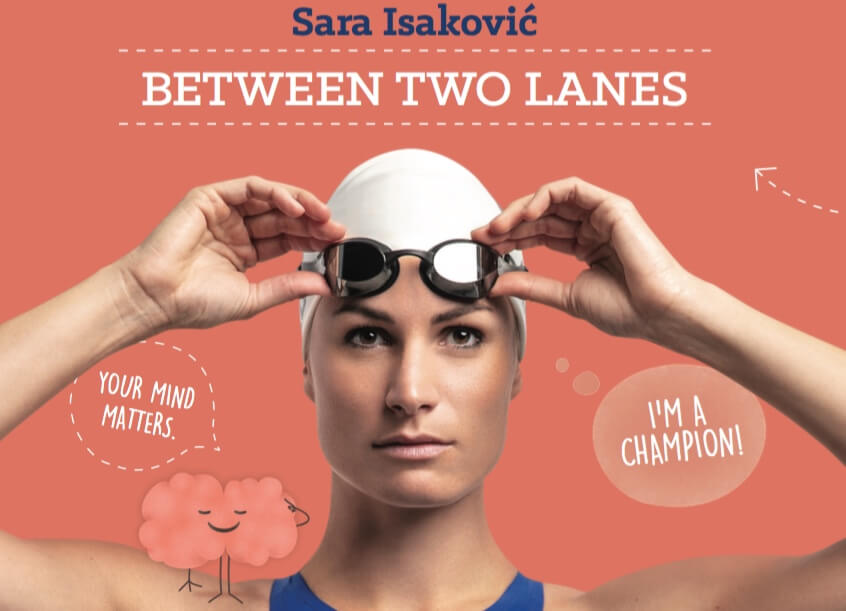
2020s Vision: Swimming Culture – Psychology
How do the development years of a swimmer contribute to delivering a mentally robust and resilient athlete prepared for the thrill and challenge of performance sport? How can the young swimmers navigate a beat of parents, coaches, schools, physical challenge, goal-setting and more armed with the tools for the job?
The mind matters. Prevailing swimming culture – the topic of Dr. Shane Gould’s thesis – has long fallen shy of a deeper understanding of what “the mind” means and how it can make or break. Developing mental skills, understanding the psychology of sport, is long-term, ongoing process, this the day we publish Dan D’Addona’s interview with Texas freshman Drew Kibler, who says:
“I made a lot of personal changes with the way I attack the season. I am getting to the point where I am mentally more capable of handling everything. I am mentally much more ready to attack things.”
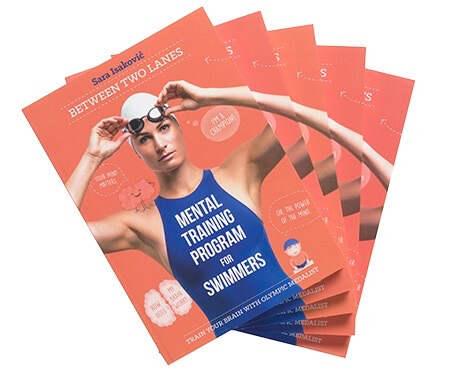
Between Two Lanes – Photo Courtesy: Andrej Peunik/ Sara Isakovic
The process of developing the mind for fight and/or flight, of course, starts much earlier. How it turns out depends on what messages the young mind receives and what it does about them.
For deeper understanding, we turn to a few guests and presenters at the
World Aquatics Conference in Lund last month, starting Sara Isakovic, the
Olympic silver medallist and Slovenian pioneer of the pool who treated the
event in Sweden to a sneak preview of her book “Between Two Lanes – a
Mental Training Program For Swimmers”. Isakovic’s early experience was that of a swimmer; her adult, academic journey has taken in more extreme situations in the realm of psychology.
Here we take a look at her book and its the program, the background and learning curve that led Sara back to the water and prompted her to put Between Two Lanes together. We then ask Sara why she feels her work is needed, why there is work to be done on psychology in swimming and how that can help swimmers have a better experience and get more out of their racing days.
Between Two Lanes – A Mental Training Program
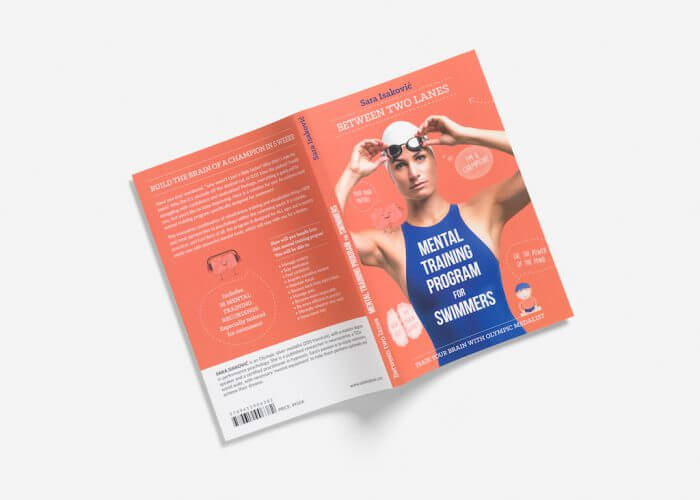
Sara Isakovic: Between Two Lanes – Photo Courtesy: Andrej Peunik
The book and accompanying program, including 36 voice recordings on mental training, is available for €49.00 (free worldwide delivery if you order 2 books or more) at Sara Isakovic’s website, where you can learn more about what she describes as “The World of Practical Performance Psychology”.
Colorfully illustrated with cartoon images and speech bubbles that make the work highly accessible for children as well as practical for parents and coaches, the book and CD takes the reader through:
- Background knowledge and understanding of mental training topics and practical psychology for daily use in and out of the pool
A four-week program of awareness training, plus 1 week of visualising guidance
Topics covered include awareness of:
- Breathing; Thoughts & Emotions; Body; Attitude; Visualisation
There are also guidance options with the program, from ‘Self-guided’ to working directly with sara Isakovic for 3 or 6 sessions.
The book is beautifully designed by Andreja Veka, the images and text pitched perfectly to the target audience:
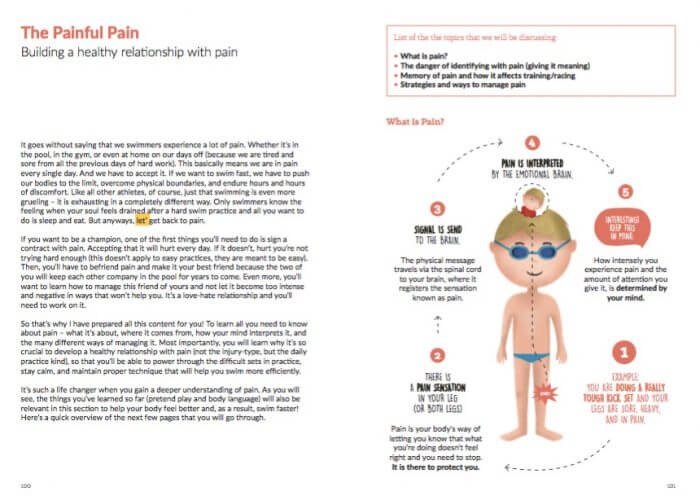
Between Two Lanes – Photo Courtesy: Sara Isakovic – designed by Andreja Veka
How Sara Got Her Head Round Her Subject
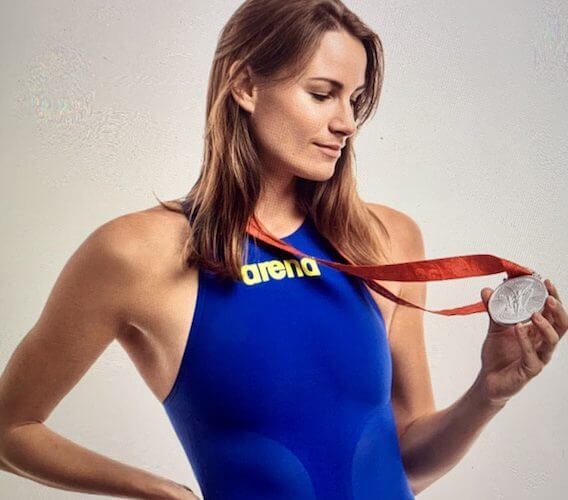
Sara Isakovic – Photo Courtesy: Samo Vidic
Sara Isakovic‘s feet had barely touched the wall before she realised she’d fallen too shy of where she’d hoped to have placed them at the most critical point of her racing career: the last turn of an Olympic final.
P=MV matters much when you have Federica Pellegrini gunning for gold in the next lane over 200m freestyle. Momentum = Mass times Velocity.
The wall means more than momentary respite and a catch of inner breath for the athlete hurtling at peak performance: it mean resurgence, revival, the net chance to drive, catch the wave, chase the goal. It’s where races can turn, twist, the torque and tension of an Olympic final dancing with fate along the chink of a tenth.
It was Beijing 2008, women’s 200m freestyle. Isakovic realised that she had rolled into her turn a touch too soon, knew that Pellegrini in the next lane and others in a tight band behind her would be rocketing off a wall feeding fuel into all four cylinders on full throttle.
She rallied, dug, clawed, grasped, pulled, kicked and willed herself back into the fight. The physical was what we saw; the mental the unseen force, the mind over matter that decided it could and would happen.
Isakovic emerged with silver 0.15sec adrift Italy’s Pellegrini, both the first inside 1:55 (shiny suited), China’s home Watercube hope Pang Jiaying 0.08sec away for the bronze.
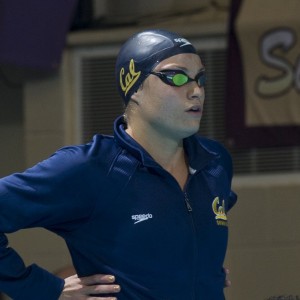
Sara Isakovic – Photo Courtesy: Peter H. Bick
Beyond Beijing, Isakovic which pathway to take next: she opted in at the University of California Berkeley, became a 3-time NCAA team champion under the leadership of coach Teri McKeever – and graduated with a degree in Psychology (emphasis on neuropsychology) in 2013.
She needed to know more so she embraced brain research at the University of California San Diego, where the neuroscience laboratory was exploring neural mechanisms of optimal performance, resilience and stress coping mechanisms in US Navy Seals, Marines and Olympic Athletes [the work of MD. Martin P. Paulus’ OptiBrain Laboratory, Department of Psychiatry, UCSD].
Next came a Masters degree in Performance Psychology at San Diego. She graduated with honors and soon put her masters thesis on Aviation Psychology, exploring the effect of mindfulness training in airline pilots, in practice: she joined the intern program at the Emirates Airlines back in her childhood home of Dubai. There in the psychology department, she built her own mental training program for airline pilots.
That project completed a circle: raised by a Slovenian mother, Rebeka, and Serbian father, Nenad, Sara and twin brother Gal traveled around the world due to her father’s profession, a pilot and pilot examiner for the Emirates Boeing B777 fleet). She spent many of her formative years in Dubai.
Now, she’s back in Slovenia, where she lectures and helps to mentally prepare performers in various realms for optimal performance within their field.
Her latest project “Between Two Lanes” seeks to provide young swimmers and their parents some key tools on the journey from fun in the water to the thrill and challenge of performance sport.
‘Making Swimming A Little Bit Less Painful, Easy & Fun’
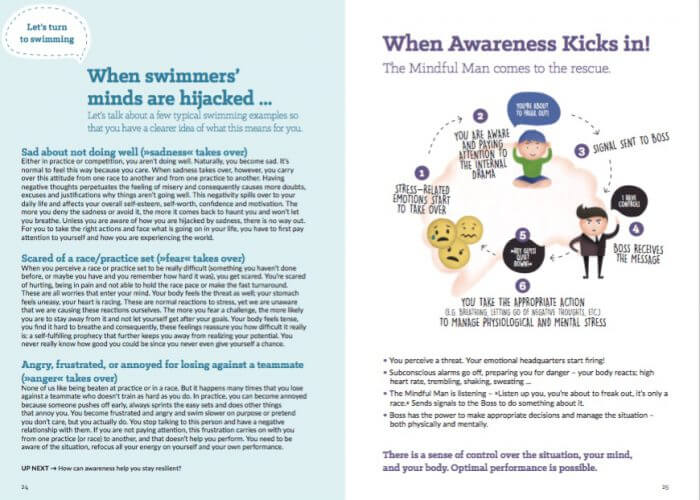
Between Two Lanes – Photo Courtesy: Sara Isakovic – designed by Andreja Vera
After listening to a terrific presentation from Jenna Love, a swim coach driven by her own experience to study psychology and neuroscience (more on that in this series soon), Sara Isakovic spoke to Craig Lord about her mission to make swimming a happier, healthier place where dreams can come true by showing them how to be the masters of their minds.
The mind, the mindset, the mental approach of the athlete, the mental health it plays into: a big theme directly linked to performance sport, athlete development and the processes children go through as swimmers, sometimes with mixed to devastating consequences that require therapy and healing long a fter the swimming is done. Is swimming at a point of awakening, a time when greater awareness is required not just by athletes but their parents, coaches and governors, among others?
“Definitely,” says Isakovic. “Just my personal view as an athlete is that if I can make
somebody’s journey a little bit less painful and easy and fun and just more manageable in a way, then that’s a good thing.”
“Let’s start with day-to-day performance and what is honestly expected of us swimmers, which is to show up at practice twice a day, spend five hours – okay four to five, sometimes I did 5 – doing physical activity in the water. What I want to help swimmers with is to make it easier for them to show up at practice and carry out the quality of practice that is needed to get them closer to the results that they dream of.
The second part of my program is visualising. Part of that is about ‘how am I able to manage my super-negatively wired mind’ because in our natural circumstances, I don’t think we’re designed to swim 16k a day.
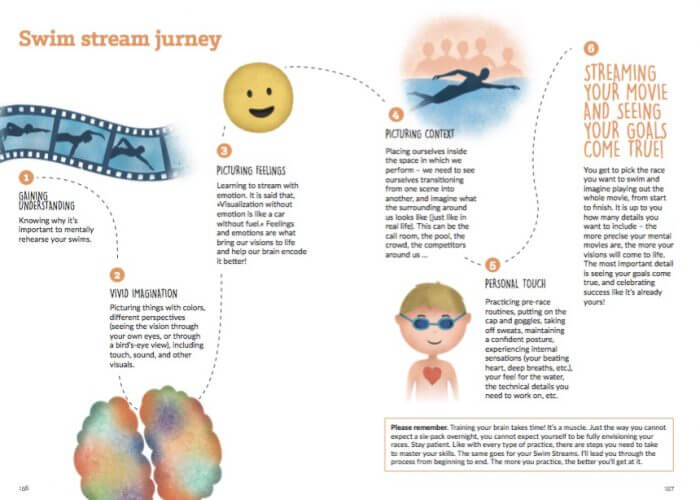
Between Two Lanes – Photo Courtesy: Sara Isakovic – designed by Andreja Veka
We have to understand what happens when we do things like that and just how the mind works. As soon as we’re faced with challenges it immediately starts throwing up excuses and, yeah, complaints – and that’s just what the mind does to help you, to
protect you from the danger that you’re perceiving to be real even though
it’s just a swim set written on a wall.
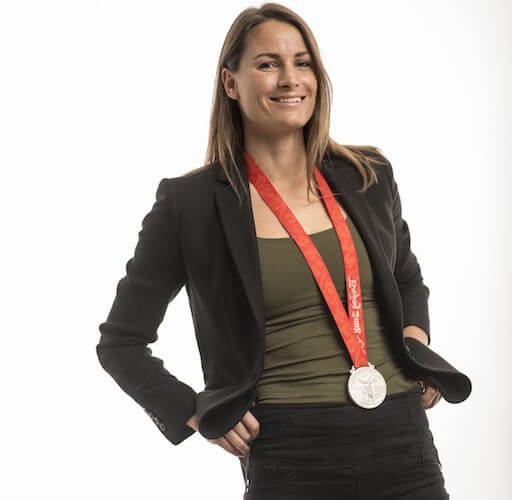
Sara Isakovic by Samo Vidic
It’s about how do you perceive a set? How do you perceive a challenge? How are you then able to, in those 20-30 seconds before asset starts, prepare for it in a mentally calm, emotionally stable way and then make sure you’re able to carry it out in the best way possible. That means ‘my focus is here’.
She points to the ground she stands on as if to say, live the moment, nothing else is significant for that moment; the mind needs to concentrate on the specific part of the task unfolding at any particular moment, with understanding go why the body is being asked to perform the challenge – and how best that challenge can be carried out to maximum benefit to the whole. She explains further:
“Right here. Now. I am doing my best, the best that I can, like, just swimming one lap at a time instead of thinking ‘Oh my God: I have 10x500s! So, it’s about really managing the quality of practice and then helping, of course, [with the coach] if it doesn’t go well, work out how you recover from that?
Has that level of awareness kind of been left to chance in the past…? Kids show up to practice but I’m not sure they’re always made aware of why they’re being asked to do what’s on the board; how to approach it beyond ‘easy, ok, pain’; is it the case that programs out there are trying on a regular basis at the development level far and wide to draw that wider, deeper awareness out of the majority of age-groupers?
“Thank you so much for that question,” says a smiling Isakovic. “No, they’re not, definitely not. I think for coaches, it’s so far not really been their job to, you know, to raise these conscious thoughts in athletes.
“Where an athlete starts complaining and crying the first go-to mechanism in Slovenia is like ‘stop crying; stop feeling sorry for yourself; It’s not even that hard; why are you complaining; come on, like yesterday was easy and before yesterday was easy; and I was one of those who just like the kid is just in tears.”
“I mean I used to be that kid, just like that, my goggles used to be filled up with tears.”
A common scene down the years? “Right … I was in a group of, like, 20 swimmers, I remember my club. Maybe there were like two of us or three of us that genuinely wanted to be there to work hard like every single day.”
She hastens to add that bragging is not her point:
“I was the only one who was luckily conscious of the fact that if I wanted to show up at practice every single day, I’m going to have to be really aware of my thoughts. Yeah, and I’m going to have to manage them and as soon as I get negative, as soon as I get caught up in the mental drama, the emotional drama, as soon as I started thinking about how some how difficult something is I can make myself cry.”
The swimmer needed to learn from a young age how to manage emotion and put it in its place, she suggested.
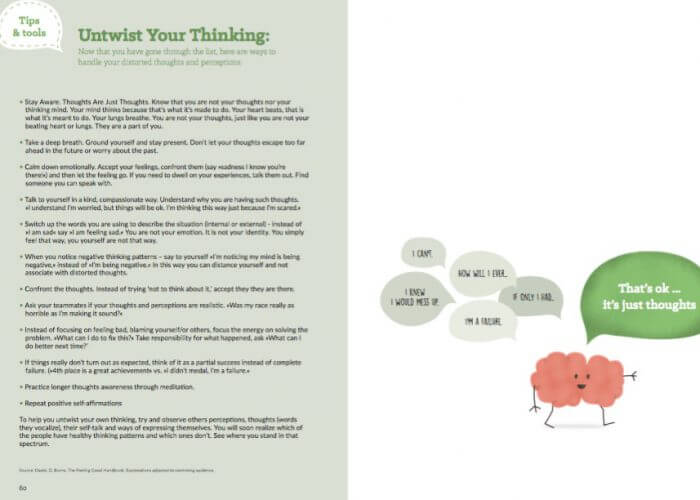
Between Two Lanes – Photo Courtesy: Sara Isakovic – designed by Andreja Veka
Transporting herself back to her junior days she explained the level of awareness she had: “Look, I can make myself cry because I’m not breathing properly. So I start breathing shallow and here I am, crying.” She demonstrates the act of making oneself cry by allowing emotion to dominate the moment with some ease.
“That’s before I even start the set; and if I then push off with that attitude, my body won’t be able to perform. I realised that early on. So, I was super Zen. I was always blowing bubbles. I was super aware of my thoughts. I learned how to not take my emotions that seriously because I know they were stress-related.
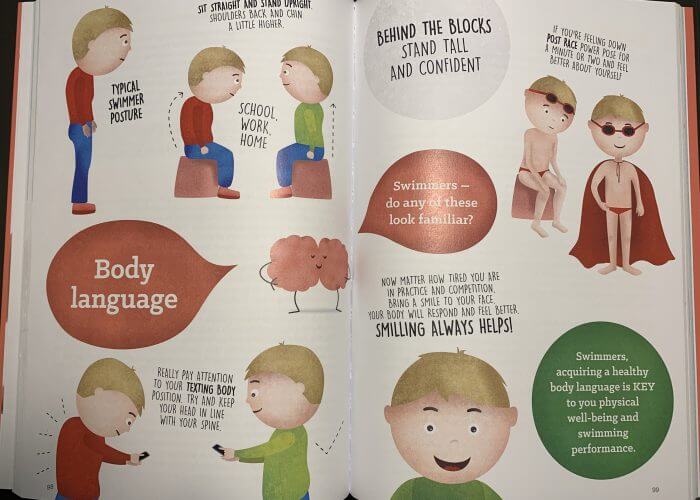
Between Two Lanes – book ragout courtesy of Sara Isakovic / designed by Andreja Vekar
“So, in that sense, It’s more about staying really present and in some sort of way be like a little mental Guru of your own. So, as I realised that, I would say to myself ‘alright, so, I have no control what thoughts are going to pop up but I really do have control on how I’m going to respond and then, well, well see what happens. Luckily, I had that experience as an athlete and I even visualised since I was 12.
“We can meditate as long as we want every single day, but visualising really helps you to prepare in advance for a certain event and that’s such an important part of my program as well, just because it gives swimmers that tool, the ability to say ‘Okay: I’m also very aware that ‘I need to be mentally ready for a very stressful event ahead of time. I need to rehearse it’.
“That’s the whole Neuroscience behind that. So I had the experience as an athlete but then studying it and just like, yeah, going into mindfulness training and brain
research: that solidified it for me.”
The Mind Of The Pilot & A Realm Where Safety Means Survival
I raise a core area of Sara’s research and work: aviation and her program of mental training for pilots. Aviation is an industry that has long had to take seriously all aspects of safety. Survival depends on it, people and business.
Sara’s father Nenad now works for Boeing as a pilot instructor and examiner, while his daughter hails from a family, including her twin brother, their uncle and grandparents, who all learned to fly.
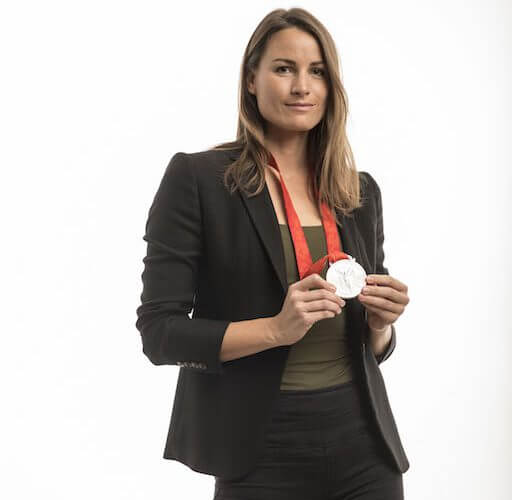
Sara Isakovic by Samo Vidic
There’s a parallel between a pilot in a simulator under the scrutiny of the examiner, avatar lives in their hands, and the swimmer rising on to the blocks for a major championship final. Essential in both scenarios to have mind and the emotions it governs in check, clear, calm, cool, even though nerves are set to ‘edge of seat’.
No-one will lose their lives, whatever happens. In aviation, of course, the simulation is indeed a part of the process designed to ensure that the same applies when the pilot is flying for real, be that solo for the fun and sport of it or at the helm of a machine carrying hundreds of paying passengers, many a sports team among them, and in other realms military personnel and so forth. Training and preparing pilots is an ongoing process that continues throughout careers.
It’s similar in swimming: the process of preparing the mind for peak performance is ongoing, long-term, and its effectiveness will play into the result. Sara explains how that plays out in the realm of pilots: “Part of my dad’s job is to build a confident training environment in sim(ulation) sessions where pilots come and perform to their optimum, maximum capacity in a stressful situation.
“The thing is, they really have the knowledge; they even have the skills. But, then they have to implement that when it matters most under scrutiny; someone’s watching me and grading me and I need to pass this exam, otherwise, my life depends on it.
“We had this conversation in the family and we talked about psychology a lot with my dad. Why is it that a pilot who has been flying great for 20 years, with a lot of experience, comes into an exam and may not perform well? Well, maybe they came to the exam a week after getting a divorce and now they need to perform … but we have to remember that this is just a sim(ulator) test; what happens when its a real-life situation? How do we ensure best performance? That’s what my Masters thesis was about: I was examining why does human error happened in catastrophes?
“It’s called the ‘startle effect’; the idea that when a human being is exposed to a really stressful situation super-suddenly, you’re under the startle effect and pilots in the air may not be able to think clearly. We’re talking about freezing and choking under stress – pilots have to instinctively know how to react.”
She refers to the recent crashes of two Boeing 737 Max 8 aircraft. Says Isakovic: “Pilots, basically, weren’t able to detect what was going on even though they had the knowledge of how to detect it … instinctively, what was happening was that the airplane was stalling and falling and they were pulling it up because instinct told them ‘I got to get us up in the air’. Whereas, if they had pulled the nose down, that would have triggered the automatic safety mechanism. It’s just one movement, right, but this is also an extreme moment, one where panic can set in.”
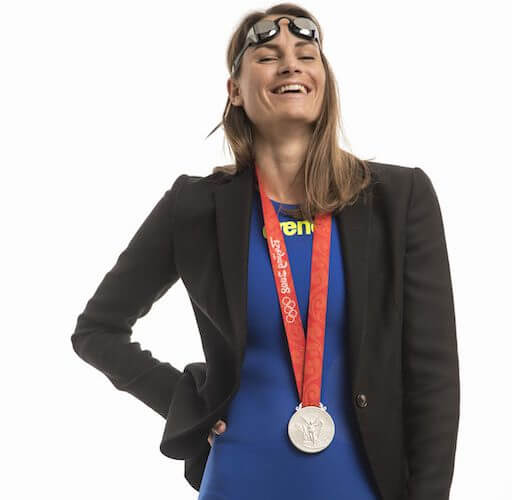
Sara Isakovic – Photo Courtesy: Samo Vidic
Crash reports identified plane design, pilot training, safety equipment that appears to have worked in the opposite direction to pilot instinct and equipment that had been sent for repair but then not tested before being used again among issues now under review. Boeing is currently cooperating with the FBI and Department of Justice in inquiries related to the crashes.
Lessons From The Extreme For The Mainstream
“We’re talking about performance in extreme situations,” says Sara.
“I prepared four Norwegian girls to row across the Atlantic and then I helped a Slovenian journalist who skied to the North Pole. So I did some of that and works with swimmers, musicians, businessmen. It’s a whole performance field where these people need to be performing optimally in a situation when it matters most. Of course, that’s the ultimate goal, but I would love people to just have an easier life.”
Just being aware of the mind, the environment around you, can make the whole experience of sport, of walking in the woods, of taking on a tough challenge in any real, all the more thrilling, can it not? Being aware that using ‘don’t’ in an instruction to kids (part of another piece to come in our series), can help make you a better coach, a better parent, right?
“Yeah, absolutely – but we have to bring out our subconscious patterns – because they are ingrained in our brains by our parents and culture and society. You have to bring it to conscious awareness and say ‘oh, these are my mental habits – are they working for me or against me?
“Maybe it would be good if I just like consciously recognize them and then decide on my own how I want to think and perceive and act and feel. It’s a conscious decision that needs to be made but you cannot act consciously on it if you’re not aware of it.”
How The Mind Is Built To Help You – Extreme To Every Day
It can often take trauma to trigger greater awareness of brain power beyond standard consciousness. I recall a write-off car crash I was involved in some 25 years ago when on a pitch-black night the debris of another accident span across the carriage and lodged itself under the engine of the vehicle I was driving. The car span, crashed through two barriers, tumbled off the road down a slope before coming to rest in a tree. The brain is an amazing cushion. It told me not to worry, it fed me a pleasant memory, slowed everything down so that what was 10-20sec of crashing, speeding mayhem felt like several minutes of a gentle merry-go-round.
The brain blocked out the things I know happened at that moment but have no direct memory of: impact bruising to wrists, ankles, chest, bump on the head from a roof imploded and so on. The police witnessed the arc of fire sent skyward by the scraping of fast-moving metal on road and were on hand all but instantly. Later on the emergency ward they appeared in the doorway with two doctors telling me ‘nothing broken’ while synchronising a low bow, hands aloft as they laughed their way through a chorus of ‘we are not worthy’. Humour is good for the brain.
My memory to this day is not of any instinct to grasp the steering wheel, of any trauma, to be honest, just one of gentle rain falling on the roof of the car, images of my then baby niece playing in the garden.
When I look up, Sara Isakovic has a tear in her eye. “How beautiful. Oh my God. I’m very touched. Amazing. When people have traumatic experiences, the brain blocks.” She mentions rape victims speaking of the mind shutting out what is happening to them (the reason why experts have said that the testimony of rape victims should not be judged on the basis of the precise details of a recollection affected by the trauma of the crime itself).
“The brain blocks out the horror of it and one day much later it can just come right out again somehow. The mind is very powerful, whatever the type or level of experience is, all of those experiences are really valuable.”
Master Of The Mind
Sara recalls her experience growing up as a swimmer trying to understand her own mind, emotion and physical dedication to her sport and how those three things interacted:
“As cheesy as it is, I really like the saying ‘master of your mind’ and I’m so happy that sport gave me the opportunity to say to myself ‘Ok, Sara, everything is possible on this planet and in this lifetime and if I can dream it, if I can see it, I can really do it.”
Fast-forward to Beijing 2008 and Sara has no doubt that her awareness of the mental process and her long-term visualisation had contributed enormously to her reaching the Olympic podium:
“I visualised my race in Beijing 300 times before I got there. I heard the commentator’s voice announcing my name, saying I’m ‘the winner of the Olympic medal, representing Slovenia’ … and I was crying in my bed, real tears, because I was experiencing it as if it was happening. Every single day the focus, the intention, the habits, I worked on it all: how to prepare for everything has to be in place. I knew exactly why I was doing it – and I knew my vision, so that really helped me.”

Between Two Lanes – Photo Courtesy: Sara Isakovic
Some parts of the process feel more mysterious but are no less real, Sara suggests: “Probably without my awareness at that stage, I worked out how to transfer the focus on pain away from pain …
“I worked out how to be playful with the water; how to use imagery in the water and pretend I’m as light as a feather; how to use my body language; how to work with identity and color; how to ask the mind to give me those commands [triggers].”
It played out like this, she says:
“When I’m swimming, I’m thinking I’m light. I’m as light as a feather. I’m as light as a feather and just encouraging myself to move through the water. ‘Come on. Let’s go’ is what you need instead of getting caught up in this mental drama that can hijack me. In that place, I’m like a prisoner and just can’t get out. It’s my choice.
“So I want every young athlete to have that choice and understand they have that choice.”
Handling Pressure – Sara Isakovic & Dr. Janet Taylor
When Sara Isakovic and psychiatrist Dr. Janet Taylor walked
Today viewers through the realm in which athletes must manage to compete without
succumbing to pressure – and how you can use the techniques they employ.
- You can buy Between Two Lanes at Sara Isakovic’s website, where you can learn more about what she describes as “The World of Practical Performance Psychology”.




Great tips for athletes, parents, and coaches.
Thank YOU!?Stay tuned for my website update! Reviews from Olympic Champions coming soon!
A must read book for anyone especially young ones who want to win prestigious medals in future Olympics. The author herself has achieved all that; for instance, she is Olympic medalist and has a Masters degree in Performance Psychology from University of California . On top of that, she is currently training young swimmers and pilots (Aviation) to achieve maximum performance under extreme pressure. Reading “Between the two Lanes” will help anyone to achieve mastery both mentally and physically.